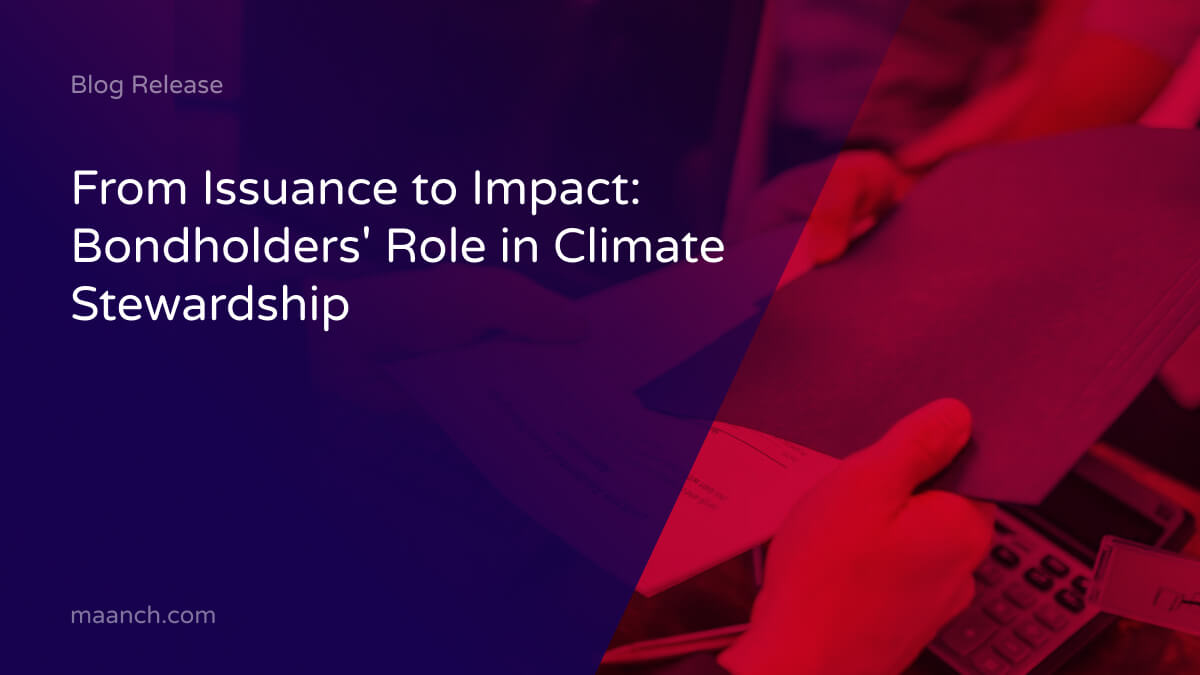As climate concerns grow, bondholders—typically focused on debt repayment—are recognising their influence on corporate sustainability. The Institutional Investors Group on Climate Change’s new guidance on Net Zero Bondholder Stewardship explores this unique role. It provides bondholders with tools to advance climate goals within a market that hasn’t traditionally focused on environmental impacts.
Understanding Bondholders’ Influence Beyond Equity:
Bondholder stewardship differs from shareholder engagement, focusing on life-cycle touchpoints—from issuance to maturity—where bondholders can affect change. This can involve financing terms tied to environmental targets or collaborative engagement between equity and debt holders to enhance climate goals. Notably, bondholders have unique leverage with state-owned enterprises and firms in emerging markets, where sustainable financing can create meaningful impact.
Unlike shareholders, bondholders cannot vote in annual meetings to influence corporate decisions. Instead, they impact issuers throughout the bond lifecycle, from issuance to maturity, establishing climate expectations and incentives within financing agreements. By doing so, bondholder actions can prompt companies to adopt sustainability goals and meet climate metrics that contribute to a Net-Zero transition.
Net Zero Bondholder Stewardship Guidance Overview:
The IIGCC’s Net Zero Stewardship Guidance for bondholders provides detailed strategies for advancing climate goals through debt investments. Key recommendations include:
- Setting Climate Objectives: Bondholder stewardship should define clear, climate-aligned goals for their investment strategies, prioritising sectors with high emissions and potential for transition.
- Engagement with Issuers: Actively engaging issuers to implement emission-reduction pathways and ensuring they align with climate goals. Bondholders should encourage issuers to adopt science-based targets.
- Enhanced Transparency: Emphasising transparency, a bondholder is advised to monitor and report on issuers’ climate performance, ensuring accurate and public reporting on climate commitments and progress.
- Collaborative Efforts: Bondholders are encouraged to collaborate with shareholders and other financial stakeholders to amplify their influence on high-emission sectors, particularly state-owned enterprises and firms in emerging markets.
- Sector-Specific Guidelines: For high-emission industries, the guidance offers specific recommendations, including integrating climate-focused covenants in debt issuance and pushing for sustainability-linked financing structures.
This framework provides a pathway for bondholders to align debt investments with Net-Zero objectives. Pushing to advance broader sustainability in the financial sector. You can read the full guidance here.

Strategies for Effective Bondholder Engagement:
Bondholders can encourage climate action through a few approaches:
- Sustainable Financing Terms – Structuring financing with climate-focused covenants or “labelled debt,” such as green bonds, where funds are earmarked for environmentally friendly projects.
- Collaborative Engagement – Teaming up with equity investors allows bondholders to leverage more influence, creating unified pressure on companies to meet climate targets.
- Sector-Specific Influence – Bondholders hold particular sway over private and state-owned entities, especially in emerging markets where sustainable practices can have substantial impact.
Bondholder stewardship holds promise in sectors like utilities and industrials, where carbon reduction is complex but critical. Bondholders can drive these sectors toward Net-Zero goals by insisting on stricter climate targets as a condition of financing.
The Role of Bondholders in the Transition to Net Zero
The IIGCC’s framework underscores how bondholder actions align debt markets with broader sustainability aims, creating a cohesive financial push toward a decarbonised economy. As more bondholders embrace this responsibility, they contribute to transforming financial markets into catalysts for environmental resilience.
For example, in 2023, Barings intensified its climate stewardship by engaging directly with project bond issuer Alfa Desarrollo. Recognising limited transparency in project finance, Barings met with Alfa’s CFO, urging better operational disclosures. Barings recommended formalising internal procedures to enhance accountability and governance at the project level. This direct engagement allowed Barings to push for embedding environmental, social, and governance (ESG) risk management practice, spotlighting how bondholders can initiate positive impact.
Automating Bond Stewardship with Maanch ET:
Maanch’s Engagement Tracker (ET) empowers bondholders to automate critical aspects of climate stewardship, making the process seamless and effective. Maanch ET helps bondholders streamline engagement, track impact, and report on climate-aligned investments:
- Automated Data Collection: Maanch ET integrates issuer data, including climate performance and sustainability metrics, allowing bondholders to assess and monitor progress automatically.
- Real-Time Engagement Tracking: Track engagements across the bond lifecycle, from issuance to maturity. Maanch ET centralises updates, ensuring teams can engage swiftly to evolving climate commitments.
- Custom Reporting Tools: Maanch ET simplifies climate reporting with customisable templates. Investment teams can generate reports for stakeholders, aligning with transparency goals and enhancing accountability.
- Integrated Collaboration: With features that facilitate collaboration, Maanch ET allows tracking of coordinated efforts with other stakeholders, enhancing collective influence over climate outcomes.
By automating data collection, tracking, and reporting, Maanch ET supports bondholders in executing effective, data-driven climate stewardship. This tool enables bondholders to focus on strategic decision-making while ensuring seamless adherence to climate goals.
Conclusion
As bondholder stewardship gains momentum, it’s clear that bondholders can significantly influence the transition to Net-Zero. The IIGCC’s guidance provides a practical framework for bondholders to engage with issuers and structure investments that support climate goals. By aligning debt financing with sustainability metrics, bondholders not only protect their investments but also promote corporate responsibility in the face of climate change. This approach underscores a transformative shift in the financial sector, where both equity and debt holders can drive meaningful progress toward a sustainable and resilient economy.



